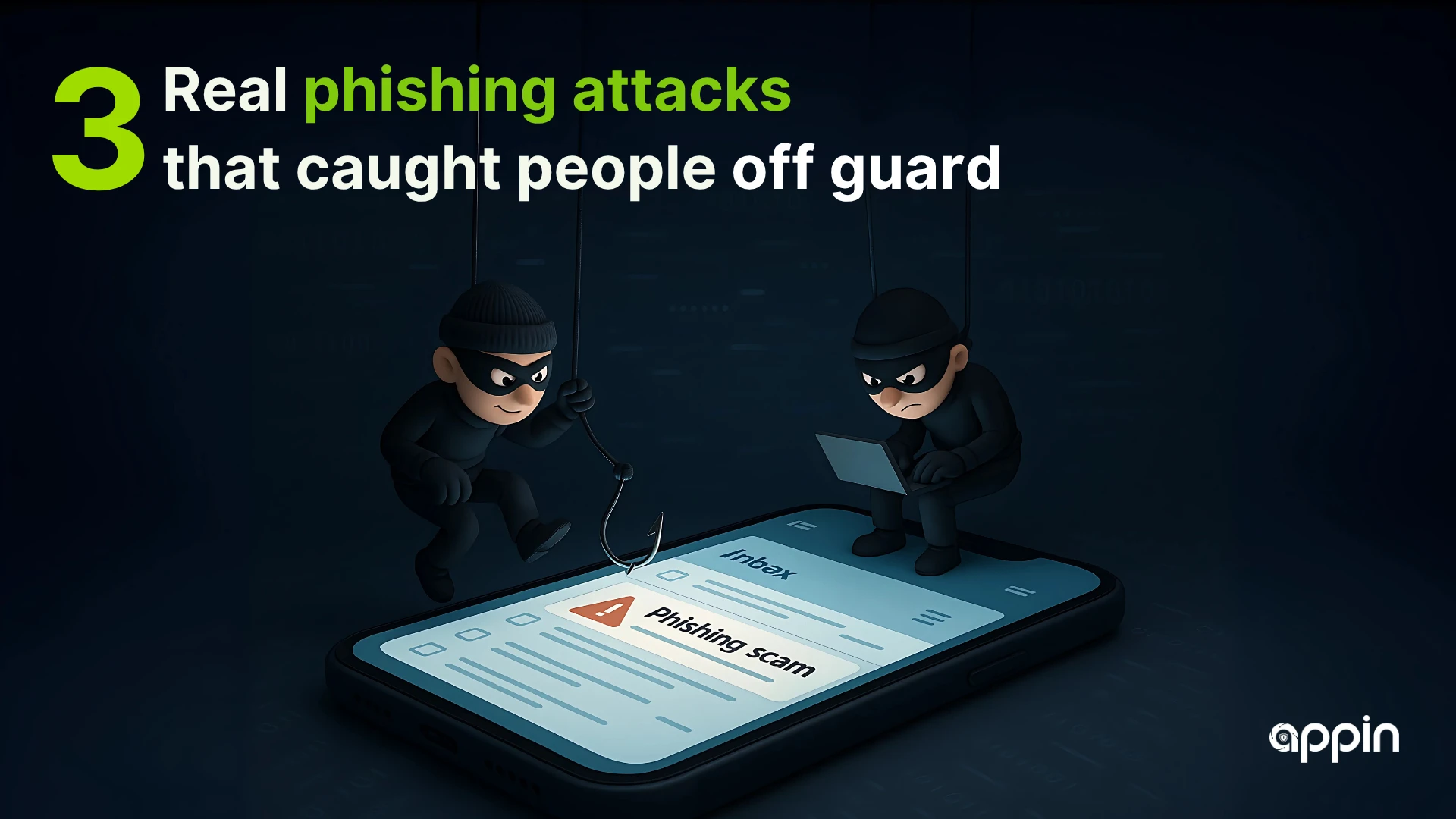Phishing is one of the most common tricks used by hackers today. It often shows up in real-life scams, emails, or fake login pages. Understanding phishing attack examples can help you avoid getting fooled and protect your personal data.
So, how does a phishing attack work? It usually starts with a fake message that looks real. It might tell you your account is at risk or that you’ve won something. The goal is simple: to make you click, share personal info, or download something harmful.
Phishing is dangerous because:
- It can look like it came from a trusted source
- It often uses fear or urgency to push action
- It targets both individuals and large companies
- Even smart users can fall for it if they’re not careful
In this blog, we’ll walk you through 3 real phishing attack examples. For each one, we’ll explain how the scam works, where it shows up, and how to spot it before it’s too late.
We’ll also share simple tips to stay safe and explain why phishing is important to understand if you’re learning cybersecurity.
Example 1: The Fake Login Page Scam
This is one of the most common types of phishing attacks. It tricks you into entering your username and password on a fake website that looks just like the real one.
How it works:
- You receive an email or message claiming your account has been locked or there’s suspicious activity
- The message includes a link to “log in and fix the issue”
- The link takes you to a login page that looks real but is controlled by the attacker
- Once you enter your credentials, the hacker now has access
Where it appears:
- Email (posing as banks, social media, or shopping sites)
- SMS (often called “smishing”)
- Ads or popups on shady websites
Example:
- You get an email from “support@yourbank.co” saying your account will be locked unless you verify it. You click the link, land on a site that looks like your bank, and enter your info. The page refreshes, shows an error, and you think it failed. But in the background, your details have already been stolen.
Red flags to spot:
- Slight changes in the URL (like “yourbannk.co”)
- Generic greetings like “Dear user”
- Spelling errors or urgent tone
- Requests for personal information you would not normally share
Example 2: The Urgent Account Warning
Another common trick found in many phishing attack examples is the urgent account warning. This type of message creates panic by making you think something is wrong with your account.
How it works:
- You receive a message claiming there’s a problem with your account
- It might say your password has been reset, your account will be locked, or a payment failed
- The goal is to make you act quickly without thinking
- You are told to click a link or download something to fix the issue
Where users are most often tricked:
- Emails pretending to be from banks, email providers, or streaming services
- Pop-ups on fake websites
- Mobile alerts that look official
Example:
- You get an email that says, “Your email account will be disabled in 24 hours due to suspicious login attempts. Click here to secure it.” You click the link, enter your password, and unknowingly give it to a hacker.
Signs to watch for:
- Urgent subject lines like “Immediate action required”
- Messages that threaten to block your account
- Links that lead to unknown or misspelled domains
- Poor grammar or unverified sender addresses
Staying calm and checking the source before clicking helps you avoid falling for these phishing attack examples.
Example 3: The Job Offer or Prize Scam
This phishing scam plays on excitement. You receive a message saying you have won a prize or been selected for a job. It sounds great, but it is a trap.
How fake rewards attract clicks:
- You get a message claiming you won a smartphone, cash reward, or part-time job
- The link takes you to a form asking for your personal details
- In some cases, you are asked to pay a small “processing fee”
- Once you respond, the attacker either steals your information or sends malware
Common formats and warning signs:
- “Congratulations! You have won…”
- Job offers that ask you to fill a form or join a Telegram group
- Emails or messages that say you were “selected” randomly
- Messages with urgent replies like “Only 2 hours left to claim”
What to avoid:
- Offers that sound too good to be true
- Requests for money or personal data
- Unverified job recruiters or random prize links
This is a classic example of social engineering in cyber security, where attackers use human emotions like excitement and urgency to trick people into acting without thinking. Always check the sender and do a quick search before responding.
Why Phishing Works (And How to Stay Safe)
Phishing works because it targets human emotions, not just systems. Most phishing attack examples succeed by triggering fear, urgency, or excitement. Hackers rely on people clicking too quickly, without checking the details.
Here are some common tactics used by attackers:
- Fear: “Your account will be blocked”
- Urgency: “Only 10 minutes left to respond”
- Greed: “You’ve won ₹10,000 cash”
- Trust: Fake emails that look like banks or companies you know
Once emotions take over, people are more likely to click links or share personal data without thinking.
To avoid falling for these tricks, follow some basic safety habits:
- Pause before you click
- Check the sender’s email address carefully
- Hover over links to see where they lead
- Avoid logging in through links sent by unknown sources
- Never share passwords or OTPs over email or chat
If you want to understand these tactics in more depth, or plan to build a career in security, consider exploring our Cyber Security Certification. Learning how these attacks work is the best way to avoid them.
Final Thoughts & Next Steps
Phishing attacks are simple but effective. As we saw in the phishing attack examples, they often look like normal messages. That is why learning to spot them is so important.
Here’s a quick recap of what we covered:
- Fake login page scams that steal your passwords
- Urgent account warnings that create panic
- Job or prize scams that use excitement to trick you
Each one uses emotion and pressure to get a quick reaction. The more you know about these tricks, the better prepared you are to avoid them.
If you’re thinking about a career in cybersecurity or just want to protect yourself online, this is a good place to start. Learning how these attacks work is the first step toward defending against them.
You can explore our CEH Course if you want to build hands-on skills. Not sure which course fits your level? Inquire Now and we’ll help you figure out the right path.
Keep asking questions, keep learning, and always double-check before you click.





